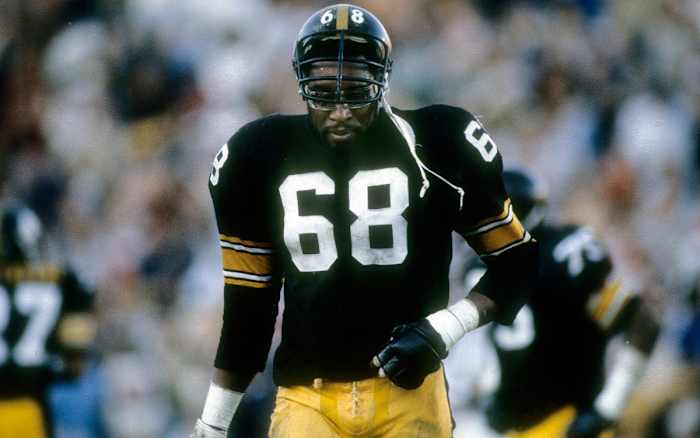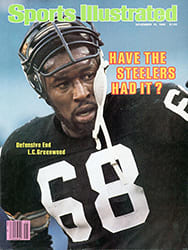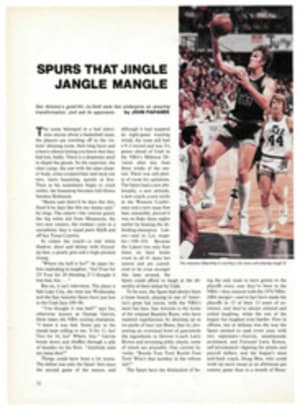This Could Be Their Last Grasp
They talked about emotion and excitement and the feel of victory after three losses in a row. They talked about Steeler football—a return to basics, an escape from finesse. They had free-lanced on defense, and when things got tight in the fourth quarter last Sunday in Three Rivers Stadium, they found one play that clicked and kept hitting the Green Bay Packers with it.
"We were hungry, our backs were to the wall," said Pittsburgh Linebacker Robin Cole. "We're just getting a taste of it again."
You could close your eyes and swear you were listening to the Eagles of a few years ago, when Philadelphia first started to emerge from the dark ages, or to the Tampa Bay Bucs of last season, when they first realized they could beat people.
But, hey, folks, these were the Pittsburgh Steelers, the Team of the '70s, the Super Bowl champions the past two years, and it was Green Bay they beat, a team even more crippled than the Steelers, a team that has been walloped by the good clubs all year. Pittsburgh won 22-20, thanks to nine points worth of miscues by a Packer reserve center. The Steelers had to struggle, and with seven weeks left in the season, one has to wonder whether they'll be playing football when January rolls around.
This week Pittsburgh visits Tampa Bay, and thus ends the NFC Central portion of its schedule. The NFC Central has been kind to the Steelers; they've built their 5-4 record largely on a 3-0 run against that division. But after the Bucs it's AFC—the A division—all the way.
Pittsburgh was written off by a lot of people after suffering three straight losses—to Cincinnati, Oakland and Cleveland—before the Green Bay game, and the Steelers needed Sunday's victory "to get that terrible, crushing weight off our back," as Joe Greene put it.
In time of triumph in Pittsburgh, age was never a topic of discussion; but now it has been pointed out that the Steelers' regular front four on defense average just under 32, that Greene and L.C. Greenwood are both 34, that these old fellows have lost the knack for the sack, and that when you can't put heat on the opposing quarterback, you're strictly a pigeon in this era of fly-boy football.
The Steelers have had last respects paid to them. After the 27-26 loss to Cleveland two weeks ago, a funeral wreath was delivered to the front office, a big one, a $50 job loaded with chrysanthemums, tinted black. "With deepest sympathies," the card read. The donor was anonymous. In the suburb of Millvale, a cardboard sign decorated with gold and black hangs from a utility pole, PRAY FOR PITTSBURGH it says.
Even the poetry has turned morbid. No city in the NFL has as many fans given to versifying as Pittsburgh does, but, lo, look what the pen hath produced. From a gentleman in Punxsutawney:
One for the thumb
Is what the fans chose,
But this year will be
One for the nose.
And from a fan in Monroeville:
Steel men kneel with heart submission
Show to ashes your contrition.
Look above—to heaven grope,
This alone may be your hope.
Mother of Mercy, is this the end of Rico? Has the dynasty really collapsed? Must we draw a line through the Steelers and look elsewhere for inspiration in the NFL?
Let's take it one step at a time.
Age. The Packers were an old team when they won their last Super Bowl in 1968. The Steelers were old when they won the Super Bowl in January. But the Green Bay dynasty collapsed when Vince Lombardi quit as coach, when those old fellows no longer had that dynamic force whipping and driving them to give that last little bit of energy. Then, all of a sudden, they were just an old team that was getting tired. Scatch that angle. Chuck Noll has no plans to retire.
How about the emergence of a rival superpower? Well, so far none has surfaced, at least not in the AFC. It's a great, gray mass out there, a tribute to Pete Rozelle's idea of parity among warring fiefdoms. No AFC team is springing away from the pack. Everyone has shown vulnerability. In the NFC, Philadelphia, Dallas and Los Angeles are showpiece teams, with Atlanta close behind, but they've all demonstrated that they can be had, too.
Steeler injuries? This is a problem that rages through the NFL like a plague. Random chance. It strikes the high and the low alike, without regard to race, creed or body build. A good rule of thumb is this: the teams that make it to the playoffs usually are the least injured down the stretch. The Steelers certainly know about this. In 1976 they were gearing themselves for a furious rush at a third straight Super Bowl, and then one morning they found themselves in Oakland for a championship game with only one healthy running back.
But the Steelers have never been hit as hard with injuries as they have been this year. Six players already have been totaled for the season. Three more are on injured reserve, and only two can be reactivated this season. Fourteen others have missed at least one game. When the Steelers lost to Cleveland by a point, they rolled out an offense that was minus its quarterback (Terry Bradshaw), both wide receivers (Lynn Swann and John Stallworth), the fullback (Franco Harris) and both starting guards (Sam Davis and Steve Courson). And yet they scored 26 points, a tribute to their depth. In his postgame message Noll finally addressed himself to the injury situation. "We've had 35 players taking medical treatment this week," he said.
In 1976, when the Steelers had to play without Bradshaw for part of the regular schedule, they rallied around the defense and had five shutouts. But that was a different era, a time when teams tried to "establish a running game." Trying to establish a running game against the Steelers was a waste of time and effort; gradually it became clear that you beat the Steelers only by throwing on them, by throwing early and by throwing a lot, especially in this day of freedom in the passing lanes.
So this year the other teams put it to the Steelers: let's see if those old boys still know how to rush the passer, let's see if their engines have rusted from disuse. Which brings us to the big problem, the obvious one: Sad Sack Syndrome.
"We lose three games by a total of four points and all of a sudden we're old and we can't rush the passer," says Middle Linebacker Jack Lambert, who has been on the sidelines for two weeks with a sprained knee. "If we'd won those three, we'd still be a dynasty, or whatever the people want to call it."
"Everybody's an expert on what's wrong with us," Noll says. "They all point to the lack of a pass rush. O.K., that's an obvious thing, easy for people to see. There's a lot more to it than that, but until we win, whatever they say is right. Until we win, they're absolute experts, and nothing we say can refute it."
But the numbers speak. After eight games this year the Steelers had 10 sacks, only one more than the worst sack total in the NFL. Last year after eight games they had 21, on their way to a very healthy total of 49. Also, opposing passers were hitting the Steelers for 218 yards a game—Green Bay's total was 266. Sure, the Steelers led the NFL in interceptions with 17, but if you give the opposition that much time to throw, it's only a matter of time until your secondary is on a psychiatrist's couch.
Noll studied the figures and then did something he didn't want to do: he reinstated team pass-rush drills. "We've always worked on our pass rush," says Noll, "but it has been one-on-one, two-on-two at the most. It's risky to work on an entire four-man rush, especially at almost full scrimmage conditions, like we're doing now. You're gambling on an injury, on somebody falling across someone's leg, or something like that."
At last Thursday's practice, Pittsburgh paid the price. John Goodman, a rookie defensive end from Oklahoma, a sack specialist who was ready to come off injured reserve, was running a stunt to the inside and collided with Greenwood, the defensive end on the other side. Goodman's knee got whacked again, and he remains on injured reserve.
Noll's drills started to pay dividends on Sunday. The Steelers sacked Green Bay's Lynn Dickey three times, tying their high for 1980. O.K., it was only the Packers, but one thing Green Bay has been able to do of late is protect the quarterback; in his four previous games Dickey had thrown for 1,045 yards and been sacked only six times. The Steelers had to get to him.
"In fairness to our defensive line," Greene says, "we'd lost our pass-rushing skills. We'd been so conditioned to play the run that they had eroded. When you rush the passer, you have to live dangerously. You have to gamble and get off the ball. You have to have a big heart and commit yourself 100% to the fighting and clawing you need to get in there."
Greene recorded his first sack of the year against the Packers, and it was a showcase job. He spun inside off the guard's block, then he split the guard and center, who had come over to help, and got to Dickey. "I can feel it coming back, the moves and the quickness," Greene said. "It's not going to come back all in one week, but it's coming. I can feel it."
Greene said he free-lanced on the play. He was supposed to take an outside route. Greenwood, another blast from the past, said he free-lanced for practically the whole game, flying down the line from the outside, chasing the ball. He had eight individual tackles, a sack and a half, a deflected pass and put heavy pressure on Dickey a couple of other times. Greenwood called it his best game since the 1979 Super Bowl.
"Maybe that's what it takes, freelancing like that, getting away from a pattern," he said. "You know you get stereotyped, and people get a hook on you. Well, I'll probably catch hell from the coaches when they look at the films and see what I was doing out there. But for the last few years we shut down the run and figured the pass rush would take care of itself. This year it hasn't. Maybe the answer now is to go into every game thinking pass rush first and assuming we can play the run from memory."
It's a neat capsule: as the Steelers' pass rush returns, so do they. But the Packers did drive 84 yards on them at the end, bringing the score to the final 22-20 with 39 seconds left. And it was two high snaps from Green Bay's backup center, Buddy Aydelette, that aborted two punts, creating a safety and setting up a short touchdown. And the game itself was a struggle against the kind of team the Steelers used to devour. Pittsburgh's offense, which had averaged 25 points a game during the three losses, was a strange creature indeed.
Bradshaw, the middle joint on his right thumb still swollen and aching from a collision with a helmet two games ago, his right elbow banged up from a fall in the second quarter, his left side alternately numb and aching from a clothesline shot he took on a scramble, admitted he "couldn't throw at all." He went 12-for-28 with two short touchdown passes—one to Swann, the other to Rocky Bleier—and two interceptions. Half the time Bradshaw was side-arming the ball.
"I probably should have taken myself out of the game," he said. "I had no control of the football. If we'd have fallen behind, I would have come out. I saw the things I wanted to take advantage of, but I just couldn't throw the ball. It's like going fishing, seeing a bed of bream down there and not having a hook."
"Was it your thumb?" someone asked.
"My thumb? God, I just hurt all over," he said. "I'm tired and sore."
Bradshaw's only long completion came in the fourth quarter, when the Steelers were protecting a 15-14 lead; it was a 38-yarder to Theo Bell on a post pattern over the middle, and it was a mistake. The Steelers had three wide receivers in the game, and all three ran inside routes.
"Theo thought he heard an audible, but it really wasn't," said Swann, who was making his first start since fracturing a rib five weeks ago. "Jim Smith and I ran the proper routes inside. Theo was supposed to go outside, but he didn't. We got our longest gain of the day on it. Emotionally, Theo heard the audible. Intellectually, it wasn't there. Maybe that tells you something about the way our luck was going today."
When it came down to the drive that gave Pittsburgh a 22-14 fourth-quarter lead and put the game away, the Steelers turned to an old friend, someone who had almost been a forgotten man—Bleier. They ran him four straight times for 38 yards—pitch right, pitch left, pitch right again, trap up the middle—and then Bradshaw hit him for a four-yard TD after a desperation scramble. The Rocky Bleier Memorial Drive.
"We found something that worked and we hammered away at it," Bleier said. "We reverted to the offense of the past, when we used to just repeat things that worked. The way their defense was set up, we knew that pitch would go, but we just hadn't used it that much. Maybe that's been our problem, both offensively and defensively. Too much finesse, second guessing, trying to fool people. That's really not our game."
O.K., so Pittsburgh reverted to Steeler football. But the Steelers beat a team that lost two linebackers during the afternoon, and Green Bay's linebacking corps was already minus one starter. Three other Green Bay starters went down in the first half, and the Packers came into the game with 16 players on injured reserve. Yet they hung in and made things tough.
Maybe this is the Steelers' level for 1980—one little notch above the NFL's desperation clubs. But maybe, as Greene says, it was the start of something, a rebirth, a return to basics. In a week or two Lambert will be back, and Stallworth, who was activated for the Packer game but didn't play, is ready now. Harris returned Sunday but departed after taking a blow to the head in the fourth quarter. That gave Bleier his chance.
A ball-control offense will keep the defense off the field and give the defense a chance to tune up its engines for the pass rush. Pass rush means better field position for the offense. The thing nourishes itself. The dark side is the calendar. If the Steelers really are a year too old, a step too slow, a little too tired, then what we saw Sunday was merely a momentary phenomenon, a last twitch before the lights go out.
The Steelers get another crack at Cleveland—in Three Rivers this time—and they play Houston on the road. They can still control the destiny of their division, the AFC Central. Don't write them off just yet. But don't start celebrating, either.


